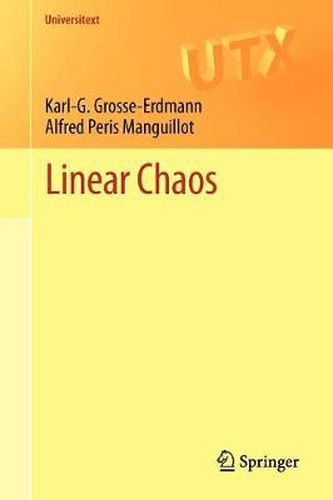Readings Newsletter
Become a Readings Member to make your shopping experience even easier.
Sign in or sign up for free!
You’re not far away from qualifying for FREE standard shipping within Australia
You’ve qualified for FREE standard shipping within Australia
The cart is loading…






This title is printed to order. This book may have been self-published. If so, we cannot guarantee the quality of the content. In the main most books will have gone through the editing process however some may not. We therefore suggest that you be aware of this before ordering this book. If in doubt check either the author or publisher’s details as we are unable to accept any returns unless they are faulty. Please contact us if you have any questions.
It is commonly believed that chaos is linked to non-linearity, however many (even quite natural) linear dynamical systems exhibit chaotic behavior. The study of these systems is a young and remarkably active field of research, which has seen many landmark results over the past two decades. Linear dynamics lies at the crossroads of several areas of mathematics including operator theory, complex analysis, ergodic theory and partial differential equations. At the same time its basic ideas can be easily understood by a wide audience.
Written by two renowned specialists, Linear Chaos provides a welcome introduction to this theory. Split into two parts, part I presents a self-contained introduction to the dynamics of linear operators, while part II covers selected, largely independent topics from linear dynamics. More than 350 exercises and many illustrations are included, and each chapter contains a further ‘Sources and Comments’ section.
The only prerequisites are a familiarity with metric spaces, the basic theory of Hilbert and Banach spaces and fundamentals of complex analysis. More advanced tools, only needed occasionally, are provided in two appendices.
A self-contained exposition, this book will be suitable for self-study and will appeal to advanced undergraduate or beginning graduate students. It will also be of use to researchers in other areas of mathematics such as partial differential equations, dynamical systems and ergodic theory.
$9.00 standard shipping within Australia
FREE standard shipping within Australia for orders over $100.00
Express & International shipping calculated at checkout
This title is printed to order. This book may have been self-published. If so, we cannot guarantee the quality of the content. In the main most books will have gone through the editing process however some may not. We therefore suggest that you be aware of this before ordering this book. If in doubt check either the author or publisher’s details as we are unable to accept any returns unless they are faulty. Please contact us if you have any questions.
It is commonly believed that chaos is linked to non-linearity, however many (even quite natural) linear dynamical systems exhibit chaotic behavior. The study of these systems is a young and remarkably active field of research, which has seen many landmark results over the past two decades. Linear dynamics lies at the crossroads of several areas of mathematics including operator theory, complex analysis, ergodic theory and partial differential equations. At the same time its basic ideas can be easily understood by a wide audience.
Written by two renowned specialists, Linear Chaos provides a welcome introduction to this theory. Split into two parts, part I presents a self-contained introduction to the dynamics of linear operators, while part II covers selected, largely independent topics from linear dynamics. More than 350 exercises and many illustrations are included, and each chapter contains a further ‘Sources and Comments’ section.
The only prerequisites are a familiarity with metric spaces, the basic theory of Hilbert and Banach spaces and fundamentals of complex analysis. More advanced tools, only needed occasionally, are provided in two appendices.
A self-contained exposition, this book will be suitable for self-study and will appeal to advanced undergraduate or beginning graduate students. It will also be of use to researchers in other areas of mathematics such as partial differential equations, dynamical systems and ergodic theory.